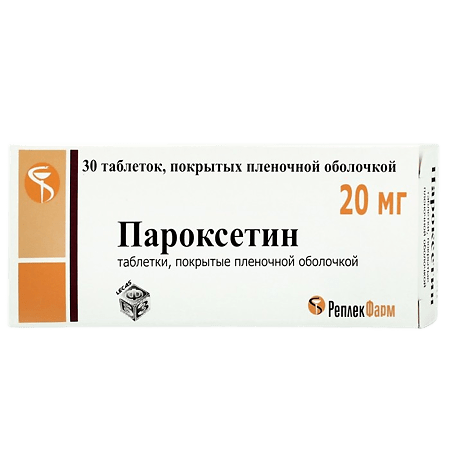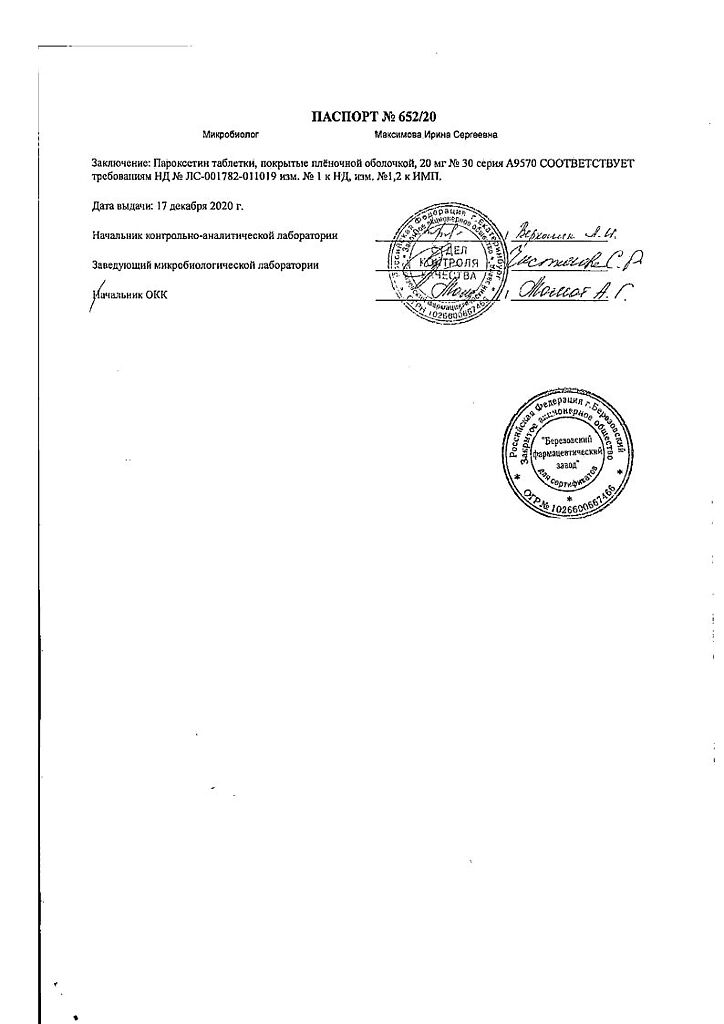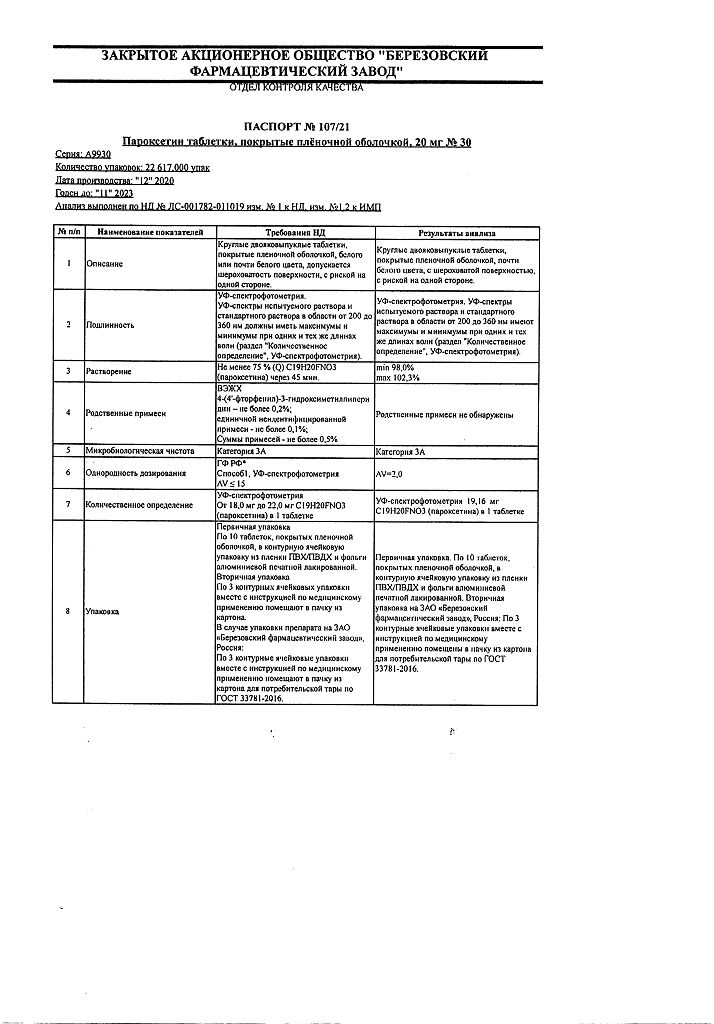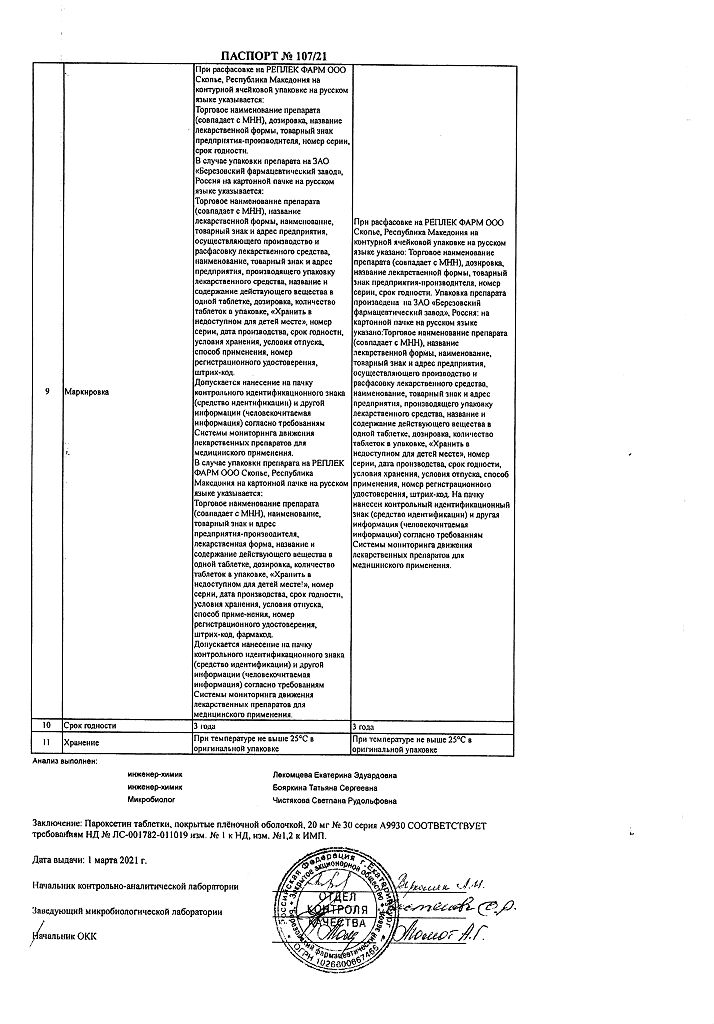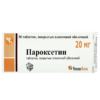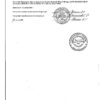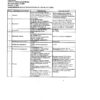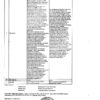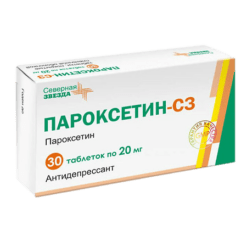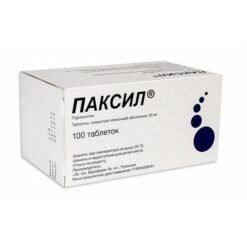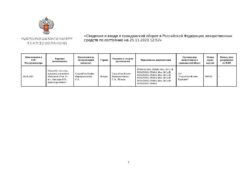No products in the cart.
Paroxetine, tablets 20 mg 30 pcs
€8.44 €7.38
Out of stock
(E-mail when Stock is available)
Description
Paroxetine is an antidepressant. It is a selective inhibitor of serotonin reuptake (5-hydroxytryptamine, 5-NT) by brain neurons, which determines its antidepressant effect and effectiveness in treatment of obsessive-compulsive (OCD) and panic disorder.
Paroxetine has low affinity for m-cholinoreceptors (has weak anticholinergic effects), α1-, α2- and β-adrenoreceptors, as well as dopamine (D2), 5HT1-like, 5HT2-like and histamine H1-receptors. Paroxetine does not impair psychomotor functions and does not potentiate inhibitory effects of ethanol.
According to behavioral and EEG studies, paroxetine shows weak activating properties when prescribed in doses higher than those necessary to inhibit serotonin uptake. It does not cause significant changes in BP, HR and EEG.
Pharmacokinetics
Intake
After oral administration, paroxetine is well absorbed from the GI tract and undergoes first-pass metabolism through the liver.
Distribution
The Css is reached 7-14 days after initiation of therapy. There is a non-linear dose-dependence of pharmacokinetic parameters with increasing dose and/or duration of treatment.
Paroxetine is extensively distributed in tissues, only 1% of it is present in plasma.
Binding to proteins is 95%.
Metabolism
Metabolized in the liver with the formation of inactive metabolites. It is an inhibitor of CYP2D6 isoenzyme.
The main metabolites of paroxetine are polar and conjugated products of oxidation and methylation, which are rapidly eliminated from the body, have little pharmacological activity and do not affect its therapeutic effect. During metabolism of paroxetine selective serotonin uptake by neurons due to its action is not disturbed.
Elimation
About 64% of paroxetine is excreted in the urine (2% – unchanged, 64% – as metabolites); about 36% is excreted with the bile through the intestine, mostly as metabolites, less than 1% – unchanged.
The excretion of paroxetine metabolites is biphasic, first by first-pass metabolism through the liver and then it is controlled by systemic elimination. The T1/2 of paroxetine varies, but averages 24 hours.
Pharmacokinetics in special clinical cases
The plasma concentration of paroxetine is increased in hepatic and renal dysfunction and in the elderly.
Indications
Indications
Depression of various etiologies, obsessive-compulsive disorder, panic disorder, social phobias, generalized anxiety disorder, post-traumatic stress disorder.
Active ingredient
Active ingredient
Composition
Composition
Active ingredient:
Paroxetine hydrochloride hemihydrate;
Auxiliary substances:
calcium hydrophosphate,
microcrystalline cellulose,
crospovidone,
p> copovidone,
colloidal silicon dioxide,
magnesium stearate,
talc;
Shell:
Hypromellose, macrogol 6000, talc, titanium dioxide
How to take, the dosage
How to take, the dosage
The tablets should be taken orally, once a day, in the morning, with a meal, swallowed whole with water.
The dose is adjusted on an individual basis over the first 2-3 weeks of therapy and thereafter, if necessary.
In case of depression, the recommended dose is 20 mg once daily. If necessary, the dose is gradually increased by 10 mg/day; the maximum daily dose should not exceed 50 mg.
In obsessive-compulsive disorders, the initial therapeutic dose is 20 mg/day with weekly increases of 10 mg thereafter. The recommended average therapeutic dose is 40 mg/day; if necessary, the dose can be increased to 60 mg/day.
In panic disorder the initial dose is 10 mg/day (to reduce the possible risk of exacerbation of panic symptoms) followed by weekly increases of 10 mg. The average therapeutic dose is 40 mg/day. Maximum dose is 50 mg/day.
In social anxiety disorder/sociophobia the initial dose is 20 mg/day, in the absence of effect for at least 2 weeks it is possible to increase the dose to a maximum of 50 mg/day. The dose should be increased by 10 mg at intervals of at least a week according to the clinical effect.
In generalized anxiety disorders, the initial and therapeutic doses are 20 mg/day.
In cases of renal and/or hepatic impairment, the recommended dose is 20 mg/day.
In elderly patients, the daily dose should not exceed 40 mg.
In order to prevent the development of withdrawal syndrome, discontinuation of the drug should be done gradually.
Interaction
Interaction
Simultaneous use of antacids does not affect absorption and pharmacokinetic parameters of Paroxetine.
The concomitant use of Paroxetine with MAO inhibitors is contraindicated.
Concomitant administration with Paroxetine increases procyclidine concentrations.
Because of Paroxetine inhibition of cytochrome P450, the effects of barbiturates, phenytoin, indirect anticoagulants, tricyclic antidepressants, phenothiazine neuroleptics and class 1C antiarrhythmic agents, metoprolol may be increased, and the risk of side effects when these drugs are prescribed concomitantly increased.
Concomitant administration with drugs that inhibit liver enzymes may require reducing the dose of Paroxetine.
Paroxetine increases bleeding time with concomitant administration of warfarin (if prothrombin time is unchanged).
Continue use of Paroxetine with atypical neuroleptics, tricyclic antidepressants, phenothiazine-based medications, NSAIDs (including acetylsalicylic acid) may affect the blood clotting process.
The concomitant administration of Paroxetine with serotonergic agents (tramadol, sumatriptan) may increase the serotonergic effect.
Mutual enhancement of the effects of tryptophan, lithium drugs and Paroxetine has been noted.
Concomitant administration of Paroxetine with phenytoin and other anticonvulsants may increase the frequency of side effects.
Paroxetine is much weaker in suppressing the antihypertensive effects of guanethidine compared to norepinephrine takeover inhibitor antidepressants.
Special Instructions
Special Instructions
In order to avoid the development of malignant neuroleptic syndrome, Paroxetine should be prescribed with caution in patients taking neuroleptics.
Paroxetine treatment is prescribed 2 weeks after withdrawal of MAO inhibitors.
In elderly patients, hyponatremia is possible during Paroxetine administration.
In some cases, it is required to adjust the dose of concomitantly used insulin and/or oral hypoglycemic drugs.
In case of seizures, treatment with Paroxetine is discontinued.
In the first signs of mania, Paroxetine therapy should be discontinued.
During the first few weeks of Paroxetine therapy, the patient’s condition should be closely monitored for possible suicide attempts.
Alcohol should be avoided during Paroxetine therapy due to its increased toxic effects.
Pediatric use
The use of Paroxetine in children is not recommended because its safety and efficacy in this group of patients has not been established.
Impact on driving and operating machinery
Although Paroxetine does not impair cognitive and psychomotor functions, patients should refrain from or use extreme caution when driving or engaging in other potentially hazardous activities that require increased concentration and rapid psychomotor reactions.
Contraindications
Contraindications
Hypersensitivity, concomitant use of MAO inhibitors (and 2 weeks after their withdrawal), age under 18 years (effectiveness and safety not established).
Side effects
Side effects
Nervous system and sensory organs: Dizziness, headache, migraine, somnolence, insomnia, hyperexcitability, nervousness, anxiety, irritability, emotional lability, asthenia, neurosis, impaired concentration, thought disorder, aggressiveness, hostility, tremors, seizures, extrapyramidal disorders, hallucinations, euphoria, mania or hypomania, confusion, agitation, depersonalization, amnesia, panic attacks, paresthesia, serotonin syndrome, visual disturbance, change in taste.
Motor system disorders: arthralgia, myalgia, myopathy, myasthenia.
Urogenital system disorders: sexual dysfunction, including disorders of ejaculation, decreased libido, anorgasmia, urinary retention or increased frequency of urination.
Gastrointestinal system disorders: decreased/increased appetite, nausea, vomiting, dry mouth, constipation/diarrhea; in very rare cases – hepatitis.
Cardiovascular system: increase or decrease in BP, orthostatic hypotension, palpitations.
Allergic reactions: rash, urticaria, ecchymosis, pruritus, angioedema.
Others: myalgia, rhinorrhea, increased sweating, hyponatremia, impaired ADH secretion, hyperprolactinemia/galactorrhea, weight loss/increase, withdrawal syndrome (when paroxetine is abruptly withdrawn).
Overdose
Overdose
Symptoms: nausea, vomiting, tremor, mydriasis, dry mouth, irritability, nystagmus, agitation, sweating, somnolence, sinus tachycardia, seizures, bradycardia, increased BP, nodal rhythm. In very rare cases, when concomitantly administered with other psychotropic drugs and/or alcohol, ECG changes, coma may occur. In severe overdose – serotonin syndrome, rarely – rhabdomyolysis.
Treatment: gastric lavage, taking activated charcoal. If necessary, symptomatic therapy is carried out. There is no specific antidote.
Pregnancy use
Pregnancy use
Pregnancy should only be prescribed if absolutely necessary.
The FDA fetal category is C.
Breastfeeding should be stopped during treatment (paroxetine penetrates into breast milk at concentrations close to those in blood serum).
Similarities
Similarities
Additional information
| Weight | 0.020 kg |
|---|---|
| Shelf life | 3 years |
| Conditions of storage | In a dry, light-protected place at a temperature not exceeding 25 °C |
| Manufacturer | Replek Farm, Republic of Northern Macedonia |
| Medication form | pills |
| Brand | Replek Farm |
Other forms…
Related products
Buy Paroxetine, tablets 20 mg 30 pcs with delivery to USA, UK, Europe and over 120 other countries.

